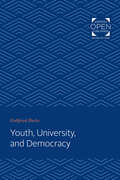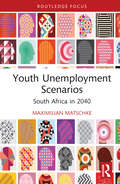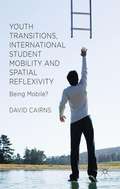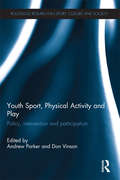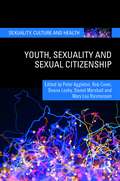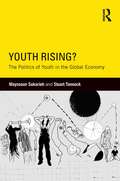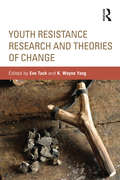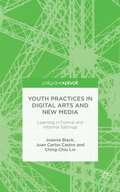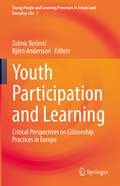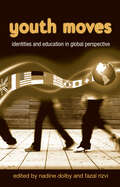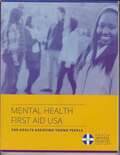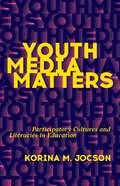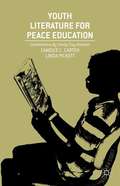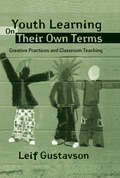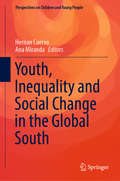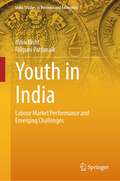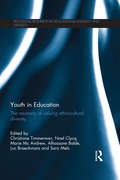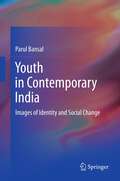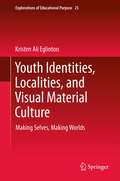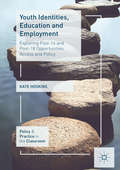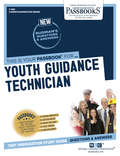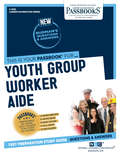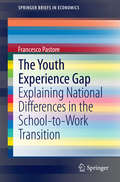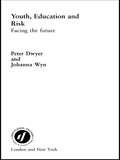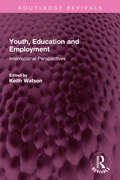- Table View
- List View
Youth, University, and Democracy
by Gottfried DietzeOriginally published in 1970. Youth, University, and Democracy examines whether Weber's approach has a greater humanizing value than has been conceded by his opponents and will attempt to demonstrate the humanistic mission of the University and its usefulness for youth and democracy.
Youth Unemployment Scenarios: South Africa in 2040 (Routledge Contemporary South Africa)
by Maximilian MatschkeThis book examines the factors driving youth unemployment in South Africa, exploring potential future outcomes of its mass unemployment, and offering a variety of strategies to avoid an impending crisis in the country. Utilizing scenario analysis rooted in complex systems theory while building on statistical and fi eld research, the author illustrates four possible future states of youth employment in South Africa in the year 2040. This includes the South African version of the Arab Spring, where young people riot or agitate for extreme political and social change because of a belief that access to education and jobs is only possible through social status or corruption (Spring), fair access to a high number of jobs supported by Chinese interventions (Summer), a technology- driven decline in the number of jobs where merit- based access for youth is granted (Fall), and the collapse of the economy, with the economy collapsing and youth becoming increasingly desperate (Winter). The author then presents five strategies to fight youth unemployment, including training of youth to start businesses, stimulating small- and medium- sized enterprises, and sending unemployed youth abroad for skills development and to where their labour is needed. This book will be of interest to scholars of South African politics and economics, labour economics and youth studies, and readers with an interest in tackling youth unemployment independent of the country.
Youth Transitions, International Student Mobility and Spatial Reflexivity
by David CairnsDrawing on comparative country case studies, this book explores student mobility in Europe, incorporating original theoretical perspectives to explain how mobility happens and new empirical evidence to illustrate how students become mobile within their present educational and future working lives.
Youth Sport, Physical Activity and Play: Policy, Intervention and Participation (Routledge Research in Sport, Culture and Society)
by Andrew Parker Don VinsonSport, physical activity and play are key constituents of social life, impacting such diverse fields as healthcare, education and criminal justice. Over the past decade, governments around the world have begun to place physical activity at the heart of social policy, providing increased opportunities for participation for young people. This groundbreaking text explores the various ways in which young people experience sport, physical activity and play as part of their everyday lives, and the interventions and outcomes that shape and define those experiences. The book covers a range of different sporting and physical activities across an array of social contexts, providing insight into the way in which sport, physical activity and play are interpreted by young people and how these interpretations relate to broader policy objectives set by governments, sporting organisations and other NGOs. In the process, it attempts to answer a series of key questions including: How has sport policy developed over the last decade? How do such policy developments reflect changes at the broader political level? How have young people experienced these changes in and through their sporting lives? By firmly locating sport, physical activity and play within the context of recent policy developments, and exploring the moral and ethical dimensions of sports participation, the book fills a significant gap in the sport studies literature. It is an important reference for students and scholars from a wide-range of sub-disciplines, including sports pedagogy, sports development, sport and leisure management, sports coaching, physical education, play and playwork, and health studies.
Youth, Sexuality and Sexual Citizenship (Sexuality, Culture and Health)
by Peter Aggleton Rob Cover Deana Leahy Daniel Marshall Mary Lou RasmussenSexual citizenship is a powerful concept associated with debates about recognition and exclusion, agency, respect and accountability. For young people in general and for gender and sexually diverse youth in particular, these debates are entangled with broader imaginings of social transitions: from ‘child’ to ‘adult’and from ‘unreasonable subject’ to one ‘who can consent’. This international and interdisciplinary collection identifies and locates struggles for recognition and inclusion in particular contexts and at particular moments in time, recognising that sexual and gender diverse young people are neither entirely vulnerable nor self-reliant. Focusing on the numerous domains in which debates about youth, sexuality and citizenship are enacted and contested, Youth, Sexuality and Sexual Citizenship explores young people’s experiences in diverse but linked settings: in the family, at school and in college, in employment, in social media and through engagement with health services. Bookended by reflections from Jeffrey Weeks and and Susan Talburt, the book’s empirically grounded chapters also engage with the key debates outlined in it's scholarly introduction. This innovative book is of interest to students and scholars of gender and sexuality, health and sex education, and youth studies, from a range of disciplinary and professional backgrounds, including sociology, education, nursing, social work and youth work.
Youth Rising?: The Politics of Youth in the Global Economy (Critical Youth Studies)
by Mayssoun Sukarieh Stuart TannockOver the last decade, "youth" has become increasingly central to policy, development, media and public debates and conflicts across the world – whether as an ideological symbol, social category or political actor. Set against a backdrop of contemporary political economy, Youth Rising? seeks to understand exactly how and why youth has become such a popular and productive social category and concept. The book provocatively argues that the rise and spread of global neoliberalism has not only led youth to become more politically and symbolically salient, but also to expand to encompass a growing range of ages and individuals of different class, race, ethnic, national and religious backgrounds. Employing both theoretical and historical analysis, authors Mayssoun Sukarieh and Stuart Tannock trace the development of youth within the context of capitalism, where it has long functioned as a category for social control. The book’s chapters critically analyze the growing fears of mass youth unemployment and a "lost generation" that spread around the world in the wake of the global financial crisis. They question as well the relentless focus on youth in the reporting and discussion of recent global protests and uprisings. By helping develop a better understanding of such phenomena and critically and reflexively investigating the very category and identity of youth, Youth Rising? offers a fresh and sobering challenge to the field of youth studies and to widespread claims about the relationship between youth and social change.
Youth Resistance Research and Theories of Change: Youth Resistance Research And Theories Of Change (Critical Youth Studies)
by Eve Tuck K. Wayne YangYouth resistance has become a pressing global phenomenon, to which many educators and researchers have looked for inspiration and/or with chagrin. Although the topic of much discussion and debate, it remains dramatically under-theorized, particularly in terms of theories of change. Resistance has been a prominent concern of educational research for several decades, yet understandings of youth resistance frequently lack complexity, often seize upon convenient examples to confirm entrenched ideas about social change, and overly regulate what "counts" as progress. As this comprehensive volume illustrates, understanding and researching youth resistance requires much more than a one-dimensional theory. Youth Resistance Research and Theories of Change provides readers with new ways to see and engage youth resistance to educational injustices. This volume features interviews with prominent theorists, including Signithia Fordham, James C. Scott, Michelle Fine, Robin D.G. Kelley, Gerald Vizenor, and Pedro Noguera, reflecting on their own work in light of contemporary uprisings, neoliberal crises, and the impact of new technologies globally. Chapters presenting new studies in youth resistance exemplify approaches which move beyond calcified theories of resistance. Essays on needed interventions to youth resistance research provide guidance for further study. As a whole, this rich volume challenges current thinking on resistance, and extends new trajectories for research, collaboration, and justice.
Youth Practices in Digital Arts and New Media: Learning in Formal and Informal Settings
by Joanna Black Juan Carlos Castro Ching-Chiu LinThe authors examine youths' practices in digital culture affecting social change, pedagogy, and creative learning practices. Knowledge about these practices is discussed, in which learning, knowledge sharing, distinct social contexts, pedagogical relationships, and artistic creative inquiry are examined in diverse formal and informal environments.
Youth Participation and Learning: Critical Perspectives on Citizenship Practices in Europe (Young People and Learning Processes in School and Everyday Life #7)
by Zulmir Bečević Björn AnderssonThis book contributes to the studies on learning processes occurring outside “traditional” socialization settings such as family and school, by analysing civic and political participation and learning experiences. In this perspective, the book delves into the connections between the concepts of learning and participation and, in various ways and from different perspectives, critically interrogates learning and participation as interrelated phenomena, with the aim of revealing complexities implicated in pathways to adulthood. Being interdisciplinary in its nature (contributors come from disciplinary backgrounds such as educational sciences, child and youth studies, social work, sociology and political science), the volume provides an up-to date analysis of contemporary issues connected to youth participation and learning. The work taps into central areas of everyday life of young people and youth meaning-making and generates and presents qualitative knowledge about what it means to be young in Europe today.
Youth Moves: Identities and Education in Global Perspective (Critical Youth Studies)
by Nadine Dolby Fazal RizviThis fascinating collection of original essays seeks to address the possibilities and dangers of young people's transnational, commodified identities; how society and educational institutions might respond to these new identities; and the consequences for democratic practices and the public sphere. Drawing together contributions from the work of both well known and emerging scholars, this collection highlights the practices of youth’s identities in the context of broadly defined educative sites, including schools, media and popular culture, community organisations, cyberspace, music, and urban landscapes.
Youth Mental Health First Aid: For Adults Assisting Young People
by Mental Health Association of Maryland Missouri Department of Mental Health National Council for Behavioral HealthDesigned to teach lay people methods of assisting someone who may be in the early stages of developing a mental health problem or in a mental health crisis.
Youth Media Matters: Participatory Cultures and Literacies in Education
by Korina M. JocsonIn an information age of youth social movements, Youth Media Matters examines how young people are using new media technologies to tell stories about themselves and their social worlds. They do so through joint efforts in a range of educational settings and media environments, including high school classrooms, youth media organizations, and social media sites. Korina M. Jocson draws on various theories to show how educators can harness the power of youth media to provide new opportunities for meaningful learning and “do-it-together production.” Describing the impact that youth media can have on the broader culture, Jocson demonstrates how it supports expansive literacy practices and promotes civic engagement, particularly among historically marginalized youth.In Youth Media Matters, Jocson offers a connective analysis of content area classrooms, career and technical education, literary and media arts organizations, community television stations, and colleges and universities. She provides examples of youth media work—including videos, television broadcasts, websites, and blogs—produced in the San Francisco Bay Area, Los Angeles, New York, and St. Louis. At a time when educators are increasingly attentive to participatory cultures yet constrained by top-down pedagogical requirements, Jocson highlights the knowledge production and transformative potential of youth media with import both in and out of the classroom.
Youth Literature for Peace Education
by Candice C. Carter Linda PickettCarter and Pickett explore how educators and families can teach peace education through youth literature and literacy development. Showing how to assess, choose, and make use of literature that can be used to teach both literacy and peace education, they walk through individual methods: recognizing and teaching different portrayals of conflict in youth literature, analyzing characterization, and examining the role of illustrations. Educators who want to incorporate peace education within a broader, literacy-focused curriculum, and peace educators looking for age-appropriate materials and methodologies will find Youth Literature for Peace Education a rich and interdisciplinary resource.
Youth Learning On Their Own Terms: Creative Practices and Classroom Teaching (Critical Youth Studies)
by Leif GustavsonYouth Learning On Their Own Terms convincingly shows how developing a respect and understanding of the youth-initiated creative practices that occur outside schools can offer educators the opportunity to directly influence their teaching in schools by making classroom spaces personally meaningful and rigorous for both students and teachers.
Youth, Inequality and Social Change in the Global South (Perspectives on Children and Young People #6)
by Hernan Cuervo Ana MirandaThis book gathers international and interdisciplinary work on youth studies from the Global South, exploring issues such as continuity and change in youth transitions from education to work; contemporary debates on the impact of mobility, marginalization and violence on young lives; how digital technologies shape youth experiences; and how different institutions, cultures and structures generate a diversity of experiences of what it means to be young. The book is divided into four broad thematic sections: (a) Education, work and social structure; (b) Identity and belonging; (c) Place, mobilities and marginalization; and (d) Power, social conflict and new forms of political participation of youth.
Youth in India: Labour Market Performance and Emerging Challenges (India Studies in Business and Economics)
by Nitin Bisht Falguni PattanaikThis book provides an overview of youth labour force and workforce participation in India and explores the dynamics of changing youth labour market in India. Despite notifying a demographic dividend phase, a significant share of youth witnessed higher exclusion (unemployment and not in employment, education or training) from the Indian labour market. Therefore, this book investigates the role of education in labour market and examines open unemployment. It conceptualizes the not-in-employment-education-or-training (NEET) status of youth in Indian context and explores the heterogeneity of NEET youth by analysing the push and pull role of demographic and socio-economic variables. Furthermore, this book examines the nexus of youth labour market status and economic growth in India to provide plausible recommendations for youth's higher, inclusive and sustained participation in the labour market and the country's development pathway. The book creates room for necessary policy interventions considering the changing dynamics of youth labour market and contemplating the challenges of skill, technology and Industry 4.0., which entails a higher emphasis on ‘re-shape’, ‘re-focus’ and ‘re-share’ for enhanced and sustained inclusion of youth in labour market. It is a necessary resource for students, researchers, policymakers, and industry partners interested in exploring and understanding the political economy of youth labour market in India.
Youth in Education: The necessity of valuing ethnocultural diversity (Routledge Research in Educational Equality and Diversity)
by Christiane Timmerman, Noel Clycq, Marie Mc Andrew, Alhassane Balde, Luc Braeckmans and Sara MelsYouth in Education explores the multiple, interrelated social contexts that young people inhabit and navigate, and how educational institutions cope with increasing ethnic, cultural and ideological diversity. Schools, families and communities represent important settings in which young people must make successful transitions to adulthood, and the classroom often becomes a battleground in which these contexts and values interact. With contributions from the UK, Belgium, Germany and Canada, the chapters in this book explore rich examples from Europe and North America to suggest strategies that can help to counter negative perceptions, processes of stigmatization and disengagement, instead prioritising peer support and cooperative learning to give pupils a renewed sense of worth. This book takes the growing ethno-cultural diversity in education systems to heart and studies the various related educational processes from a multidisciplinary and multi-method approach. It aims to offer more insight into underlying mechanisms that are often implicit, but can be important factors that positively or negatively influence educational trajectories and outcomes. It is essential reading for researchers, academics and postgraduate students in the fields of education, sociology, higher education, policy and politics, and social and cultural geography.
Youth in Contemporary India
by Parul BansalThis book endeavors to be a study of identity in Indian urban youth. It is concerned with understanding the psychological themes of conformity, rebellion, individuation, relatedness, initiative and ideological values which pervade youths' search for identity within the Indian cultural milieu, specifically the Indian family. In its essence, the book attempts to explore how in contemporary India the emerging sense of individuality in youth is seeking its own balance of relationality with parental figures and cohesion with social order. The research questions are addressed to two groups of young men and women in the age group of 20-29 years-Youth in Corporate sector and Youth in Non Profit sector. Methodologically, the study is a psychoanalytically informed, process oriented, context sensitive work that proceeds via narrations, conversations and in-depth life stories of young men and women. Overall, the text reflects on the nature of inter-generational continuity and shifts in India.
Youth Identities, Localities, and Visual Material Culture
by Kristen Ali EglintonThis invaluable addition to Springer's Explorations of Educational Purpose series is a revelatory ethnographic account of the visual material culture of contemporary youths in North America. The author's detailed study follows apparently dissimilar groups (black and Latino/a in a New York City after-school club, and white and Indigenous in a small Canadian community) as they inflect their nascent identities with a sophisticated sense of visual material culture in today's globalized world. It provides detailed proof of how much ethnography can add to what we know about young people's development, in addition to its potential as a model to explore new and significant avenues in pedagogy. Supported by a wealth of ethnographic evidence, the analysis tracks its subjects' responses to strikingly diverse material ranging from autobiographical accounts by rap artists to the built environment. It shows how young people from the world's cultural epicenter, just like their counterparts in the sub-Arctic, construct racial, geographic and gender identities in ways that are subtly responsive to what they see around them, blending localized characteristics with more widely shared visual references that are now universally accessible through the Web. The work makes a persuasive case that youthful engagement with visual material culture is a relational and productive activity that is simultaneously local and global, at once constrained and enhanced by geography, and possesses a potent and life-affirming authenticity. Densely interwoven with young people's perspectives, the author's account sets out an innovative and interdisciplinary conceptual framework affording fresh insights into how today's youth assimilate what they perceive to be significant. Supported by a wealth of ethnographic evidence, the analysis tracks its subjects' responses to strikingly diverse material ranging from autobiographical accounts by rap artists to the built environment. It shows how young people from the world's cultural epicenter, just like their counterparts in the sub-Arctic, construct racial, geographic and gender identities in ways that are subtly responsive to what they see around them, blending localized characteristics with more widely shared visual references that are now universally accessible through the Web. The work makes a persuasive case that youthful engagement with visual material culture is a relational and productive activity that is simultaneously local and global, at once constrained and enhanced by geography, and possesses a potent and life-affirming authenticity. Densely interwoven with young people's perspectives, the author's account sets out an innovative and interdisciplinary conceptual framework affording fresh insights into how today's youth assimilate what they perceive to be significant. Supported by a wealth of ethnographic evidence, the analysis tracks its subjects' responses to strikingly diverse material ranging from autobiographical accounts by rap artists to the built environment. It shows how young people from the world's cultural epicenter, just like their counterparts in the sub-Arctic, construct racial, geographic and gender identities in ways that are subtly responsive to what they see around them, blending localized characteristics with more widely shared visual references that are now universally accessible through the Web. The work makes a persuasive case that youthful engagement with visual material culture is a relational and productive activity that is simultaneously local and global, at once constrained and enhanced by geography, and possesses a potent and life-affirming authenticity. Densely interwoven with young people's perspectives, the author's account sets out an innovative and interdisciplinary conceptual framework affording fresh insights into how today's youth assimilate what they perceive to be significant.
Youth Identities, Education and Employment
by Kate HoskinsThis book investigates how policy, family background, social class, gender and ethnicity influence young people's post-16 and post-18 employment and education access. It draws on existing literature, alongside new data gathered from a case study in a UK state secondary school, to examine how policy changes to the financial arrangements for further and higher education and the changing youth employment landscape have had an impact on young people's choices and pathways. Hoskins explores a number of topics, including the role of identity in young people's decision-making; the impact of changes to young people's financial arrangements, such as cuts to the Education Maintenance Allowance and increased university fees; and the influence of support from parents and teachers. The book will be of interest to students and researchers of Education and Sociology.
Youth Guidance Technician: Passbooks Study Guide (Career Examination Series #C-920)
by National Learning CorporationThe Youth Guidance Technician Passbook® prepares you for your test by allowing you to take practice exams in the subjects you need to study. It provides hundreds of questions and answers in the areas that will likely be covered on your upcoming exam.
Youth Group Worker Aide: Passbooks Study Guide (Career Examination Series)
by National Learning CorporationThe Youth Group Worker Aide Passbook® prepares you for your test by allowing you to take practice exams in the subjects you need to study. It provides hundreds of questions and answers in the areas that will likely be covered on your upcoming exam.
The Youth Experience Gap
by Francesco Pastore"The education to work transition of young people is key to a successful work-life and to fight youth unemployment. The book provides an impressive outline of the facts and convincing insights of the potential causes. This offers a large and broader audience help to adjust properly to achieve a better life. " Klaus F. Zimmermann, IZA, Bonn, Germany This work points to the youth experience gap as a key concept to explain the meager employment opportunities and earnings many young people face. The transition from education to work remains a long dark tunnel around the world. However, this book shows that there are striking differences between countries: in Germany, the young people of today are no worse off than their adult counterparts, while in Southern European and Eastern European countries they fare 3 through 4 times worse. The current economic and financial crisis has further exacerbated the situation for young people in many advanced economies. Observers are divided as to the optimal design of youth employment policy. Liberalists believe that the market itself should address youth disadvantages. More flexible labor markets should also guarantee greater labor turnover, including temporary work, so as to allow young people to move from one job to the next until they accumulate the work experience they need to become more employable and find the right career. In contrast, other economists oppose approaches focusing on entry flexibility and temporary work, claiming that the former type helps only the most skilled and motivated target groups, while the latter only allows young people to gather generic, not job-specific work experience.
Youth, Education and Risk: Facing the Future
by Johanna Wyn Peter DwyerYouth, Education and Risk: Facing the Future provides a provocative and valuable insight into how the dramatic social and economic changes of the last twenty years have affected the lives of Western youth. Covering young people's attitudes towards relationships and health, the authors provide a comprehensive perspective on young people in Western society in the 1990s.The book reviews ten years of research, policy and practice as related to the 15-25 age group and compares data from the UK, Australia, the USA and Canada. It also argues for the need to develop new research and policy frameworks that are more in tune with the changed conditions of life for Western youth. The book sets out the conceptual basis for a new approach to youth and the practical implications for research, education and youth policy in the new millenium.
Youth, Education and Employment: International Perspectives (Routledge Revivals)
by Keith WatsonFirst published in 1983, Youth, Education and Employment tries to highlight the scale of the problem of youth unemployment in industrial societies by examining it from a variety of angles, and by drawing upon developments in other countries including those of the developing world. Examples are taken from France, Germany, Denmark and Sweden as well as from the United Kingdom, and also from Cuba and small island communities. This important volume shows the underlying causes of youth unemployment and offers positive solutions in particular stressing the need for a reappraisal of many educational practices. This book is a must read for educationists, policy makers and students of public policy.
